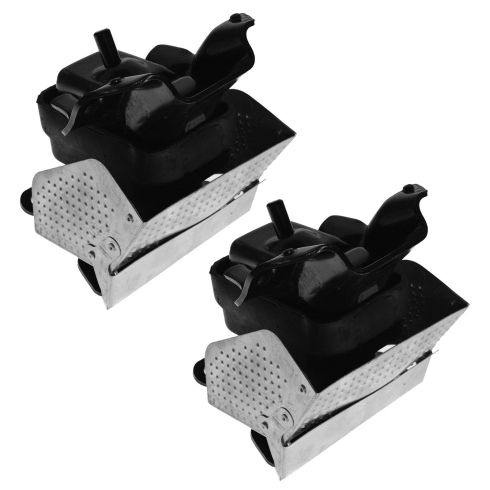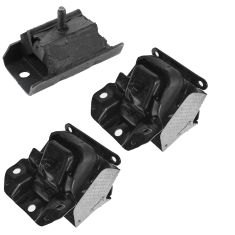1AEEK00648-Chevrolet GMC Cadillac Front 2 Piece Engine Mount Set TRQ MTA71126
Replaces
2010 Cadillac Escalade ESV Front 2 Piece Engine Mount Set TRQ MTA71126
Product Reviews
Loading reviews
4.67/ 5.0
30
30 reviews
Nice quality
March 14, 2017
Mounts are not easy to change, but these fit well and insulate at least add good as stock. Thank you.
2009 Silverado 5.3
February 12, 2018
Shipped promptly, price is good and fit my truck. Only issue I have was that it wasnt packaged very well when shipped and while it said fragile on the box, it arrived with the heat shields significantly damaged. The box was way oversized for what these were and there was no packing in the box to keep them from moving around or getting crushed. I managed to bent the heat shields back into place somewhat but I was very disaapointed with how it was shipped and handled
Gmc Truck
February 26, 2018
This product is a exact fit love the guys at 1 A auto
perfect fit and back to normal performance
March 26, 2018
A good product with reasonable pricing. My 120k mile Tahoe tore the left mount and was clunking on acceleration. A mount check revealed both mounts with excessive play ( I tow a good sized boat. It doesn't surprise me). I installed these mounts and am very happy with the results.
Poor quality control
June 26, 2018
After hours of trying to figure out why I could not get the top bolts to thread, I compared the old mount with a new one and realized the bolt hole cutouts in the heat shield were too small to allow for the flanged bolt to pass through to thread into the engine. Fortunately,I was able to cut the shield from under the truck to bend them enough to gain access for the bolts to pass
not good
November 28, 2018
I bought these in March in July/August I started having problems again. Me knowing I had just replaced them in March that they could not be the problem now. Went to another shop to have other work done, and this mechanic stated I needed motor mounts. Again me in denial I ignored him. Just put a transmission in my car thinking everything should definitely be running smooth now get my car back, and surely I need motor mounts again! More labor and buy parts again. WASTE OF MONEY!
Works great
July 13, 2019
They were same size and bolt pattern. They looked exactly like the factory ones. Time will tell on the durability but the installation went well.
Good quality product
July 29, 2019
Great products for an awesome price!
Engine mounts
October 4, 2019
These engine mounts were perfect fit they were the complete mount the ones from other auto stores you have to split the mount and add factory upper bracket to the new mount but not with the 1AAUTO mounts they were ready to bolt on straight out of the box Thanks for the awesome products.
Engine mount
January 4, 2020
Great part at 1/4 of the price of the dealership. This is my go to site when I need auto parts 90% of the time I get a way better deal here.
I have even recommended family and friends buy their parts here.
Thank you 1a auto.
GM engine mounts
February 25, 2020
Quality is great. Feels just like oem and the fitment is right on. Ive installed plenty of these mounts and this was like it came straight from the dealer parts
Basic Chevy motor mounts
April 6, 2020
They look and fit like so the other ones I've torn up. My Tahoe likes to eat the motor mounts fairly regularly and I have no reason to think these will last any more/less than the others. Great price.
Motor mounts
May 3, 2020
Perfect fit
good quality parts
September 27, 2020
parts came on time and fit i only buy my parts from 1a auto never had any problems and at a lower price
Engine Mounts
October 4, 2020
Parts arrived as promised, fit was correct.
Works as expected
November 9, 2020
Fixed my issue. No more "engine jump" upon acceleration.
Handyman Services
November 23, 2020
The Motor mounts were the correct ones . They fit right in the old mounts with no problem .Price was very good shipping was good everything went well will use this site again to order auto parts.Louis Furtado
Motor Mounts
July 22, 2021
Good parts at a GREAT price!
Worn out
September 7, 2021
So far so good. My drivers side engine mount rubber was worn out thus making the engine jump when shifting it into gear. Replaced with the new 1A Auto engine mount as is good as new again. I still have yet to replace the right one. The left took me about 3 hours to get it in there.
February 4, 2022
Fit perfect, video was right on.
February 6, 2022
hard to put on but works great
Thank you
September 12, 2022
Great product
November 3, 2022
Product worked great
January 4, 2023
Great product.
January 13, 2023
Good par lak
Engine mount ????????
February 21, 2023
It was what I expected great quality
September 14, 2023
Excellent product !
It Fits!
November 2, 2023
Love it these parts are for the 4x4 model.
Parts were great, job was tough.
January 20, 2024
These replacement mounts were a perfect fit, but the job was tough for a home mechanic without a lift or air tools. Set aside at least 4 hours for this job on a 4WD, 5 hours if you don't want to bleed.
November 19, 2024
Good Product, Made My Tahoe feel a whole lot better , had a very bad mount before i installed this 2 piece set
Customer Q&A
Will this fit 6.3 engine?
December 29, 2016
10
Based on your vehicle's year, make, and model this will fit either a 5.3L V8, or a 6.2L V8 engine.
December 29, 2016
Alex P
What company manufactures these mounts?
June 2, 2019
10
These are generic mounts just like you would buy at the local auto parts store. These are good other than one breaking a bolt when I took it apart to slide it under the engine. I had to buy another set from the local auto parts.
I sold my truck so I have no idea how they are holding up, at this point in time.
June 2, 2019
Jose L
10
Yes, according to the information you provided, this part will fit your vehicle.
June 2, 2019
Emma F
10
1A Auto's house brand parts are manufactured by various aftermarket companies specifically for us and built to your vehicle's exact OEM specifications.
June 2, 2019
Andra M
Will thisll fit my 2008 Sierra 2wd??
July 26, 2021
10
This will fit the 2005 GMC Sierra 1500 as long as it has either the V8 5.3L or V8 6.2L engine.
July 27, 2021
Andra M
Will these fit my 2007 GMC Sierra 1500 new body 1500 4x4 V8 5.3L?
January 13, 2023
10
Yes
January 13, 2023
Juan D
10
Yes they fit 2007-2013 Chevy/gmc Silverado/sierra
January 13, 2023
Joseph C
10
No, this kit is only listed for the 2007 GMC Sierra 1500 with New Body Style with the V8 6.2L. This part will not be correct for the 2007 models with the 5.3L engine.
January 16, 2023
Jessica D
Cadillac is a registered trademark of General Motors Company. 1A Auto is not affiliated with or sponsored by Cadillac or General Motors Company.
See all trademarks.









